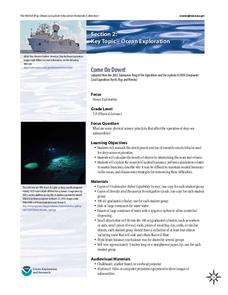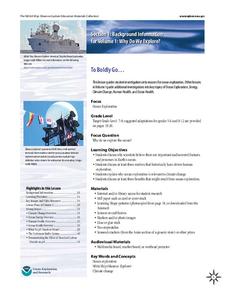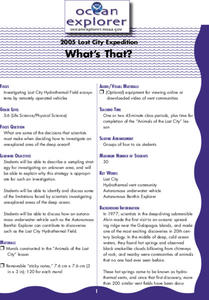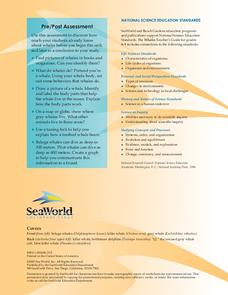Curated OER
Under Pressure: How Deep Can They Dive?
Students explore geography by conducting an in-class experiment. In this deep sea exploration instructional activity, students identify the different zones of the ocean and utilize water bottles, masking tape and scissors to conduct a...
Curated OER
Now Take a Deep Breath
Students research to answer questions related to deep sea diving. In this deep sea diving lesson, students answer questions on a worksheet using the Internet. They discuss pressure, gas laws, and the physiology of diving in the deep sea.
Curated OER
Descending to the Challenge: Developing Documentaries About the Deep Ocean
The video clip that comprises the warm up is not available, but the related article from The New York Times and the movie trailer for Aliens of the Deep are, leaving enough material to make this a fascinating lesson on deep-sea...
Curated OER
Depth Line
Students use adding machine tape to plot increasing ocean depths and deep sea historical events.
NOAA
Come on Down!
What do we do when a dive is too dangerous for humans to accomplish? Send in the robots! Middle school scientists get acquainted with several different models of submersible robots in the second lesson of six from NOAA. Lab groups then...
Curated OER
Unsafe Waters
Students investigate deep sea explorations and the challenges that can occur. In this deep-sea exploration instructional activity students work in groups and create a deep sea exploration mural.
NOAA
A Quest for Anomalies
Sometimes scientists learn more from unexpected findings than from routine analysis! Junior oceanographers dive deep to explore hydrothermal vent communities in the fourth lesson in a series of five. Scholars examine data and look for...
NOAA
To Boldly Go...
When we think of ocean exploration, many of us have visions of sunken pirate ships full of treasure or mysterious creatures of the deep. What really motivates deep-sea investigation? The first in a series of diverse six-part lessons...
Curated OER
Surviving Extremes
Students examine the potential health dangers of mountain climbing in high altitudes and deep-sea diving. They write a health and safety column for a fictional magazine about extreme outdoor sports that explains the risks involved in...
NOAA
A Day in the Life of an Ocean Explorer
What's life like aboard an ocean exploration vessel? Junior oceanographers examine the important role of communication in ocean research in lesson two of a five-part series from NOAA. The materials introduce the class to life on...
Curated OER
The Eyes Have It!
Reading essays about deep-sea expeditions open this lesson on crustacean vision. Marine biology explorers study the compound eye and then complete a worksheet in response to all they have discovered. Although the lesson doesn't offer an...
Curated OER
What's That?
Meant to be a simulation of a deep-sea exploration, this requires that another lesson be completed first. In that lesson, titled "Animals of the Lost City," marine biology buffs construct murals of benthic communities. For this lesson,...
Curated OER
A Vacation Expedition: Universal Design and Differentiated Instruction Lesson
Students plan a vacation to either a mountain, deep-sea location, rainforest or to the moon. In this vacation planning lesson, students research information about the location of their choice. They watch video clips on the SMARTBoard,...
Sea World
Whales
A whale of a lesson is sure to intrigue your elementary oceanographers! Learn about the mammals of the sea with a series of activities about whales, dolphins, and porpoises. Kids complete worksheets about the anatomy of a whale, create a...
NOAA
Through Robot Eyes
How do robots assist ocean explorers in collecting data and images? The final installment in a five-part series has science scholars examine underwater images collected by robots and identify the organisms shown. Groups then calculate...
Curated OER
WNBA Supermom and Elapsed Time
Students watch a video of an WNBA athlete to learn about calendar scheduling and elapsed time. In this time management lesson, students watch the video for the WNBA athlete. Students record tips about time management and then complete...
Curated OER
Cool Lights
Students investigate how and why deep-sea organisms produce light. They examine how these processes can be used to study deep ocean environments.
Curated OER
Too Hot? Gotta Vent!
Students study deep sea exploration and underwater geology, specifically hydrothermal sea vents. They create digital video projects of their own to demonstrate their knowledge, illustrating the discoveries of the explorers of the ocean's...
Curated OER
Designing an Underwater Habitat for Humans
Young scholars consider the limitations of deep water oceanography and design an underwater habitat to support scientists while they complete long term studies under the ocean. In this engineering lesson, students are introduced to the...
Curated OER
AdVENTurous Findings on the Deep Sea Floor
Students conduct investigations to observe formations of precipitates, then create models of developing hydrothermal vents. They compare the models with the actual hydrothermal vents developing along the Galapagos Rift.
Curated OER
Who Has the Light?
Students study ways in which the ability to produce light may be useful to deep-sea organisms. In groups, they research and present to the rest of the class, how a specific organism is able to produce bioluminescence.
Curated OER
Breaking News: Virgin Voyage to the Bottom of the Ocean (7th April, 2011)
Students explore current events by reading about a trip to the bottom of the ocean. In this modern day explorer lesson, students read about Virgin CEO Richard Branson and his adventure to the bottom of the ocean. Students complete...
Virginia Department of Education
Partial Pressure
At some point, everyone has been under pressure—even Dalton! Explore Dalton's law of partial pressures with young chemists as they measure the volume of air extracted from a sample compared to its original volume. Class...
Curated OER
Week 8 - Sea Life
Using a magnifier, mini marine biologists examine the barbules of a bird feather. They swirl the it into a mixture of oil and water and then re-examine the feather. After the activity, discuss how the oily feathers pose a problem to...























